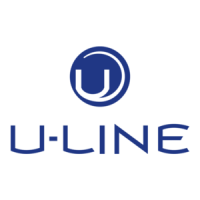Why are my U-Line H-3045 Trucks leaking?
- DDavid WelchAug 15, 2025
If your U-Line Trucks are leaking, it's likely due to worn or damaged seals. Replace the seals with new ones. Also, check for cracked or worn-out parts and replace them as needed.

Why are my U-Line H-3045 Trucks leaking?
If your U-Line Trucks are leaking, it's likely due to worn or damaged seals. Replace the seals with new ones. Also, check for cracked or worn-out parts and replace them as needed.
Why do the forks descend without being lowered on my U-Line Lifting Systems?
If the forks on your U-Line Lifting Systems descend without being lowered, it could be due to impurities in the oil preventing the discharge valve from closing properly. Try changing the oil. Another possible cause is air in the hydraulic oil; in this case, you should expel the air.
What to do if my U-Line Lifting Systems has leaks?
Leaks in your U-Line Lifting Systems can be caused by worn out or damaged seals. Replace the seals with new ones. Also, check for cracked or worn out parts and replace them as needed.
Why do the forks on my U-Line Lifting Systems not raise?
If the forks on your U-Line Lifting Systems do not raise, it could be due to several reasons. First, check if there is enough hydraulic oil and add more if needed. The oil might have impurities, requiring an oil change. The discharge valve may be out of adjustment, so adjust the setting screw. Additionally, air in the hydraulic oil can cause this issue; expel the air.
What to do if the forks do not descend on my U-Line Lifting Systems?
If the forks on your U-Line Lifting Systems do not descend, it could be because the rod and/or the cylinder are deformed due to a seriously unbalanced load. Replace the rod or cylinder. Another possibility is that a part has been broken or deformed from an unbalanced load; repair or replace the component. Also, the setting screw may not be in the correct position, so adjust it.
What to do if the forks on my U-Line H-3045 do not raise?
If the forks on your U-Line Trucks aren't raising, several issues could be the cause. First, check if there is enough hydraulic oil and add more if needed. Secondly, the oil may have impurities, in which case you should change the oil. Other potential causes include a discharge valve that is out of adjustment, which requires adjusting the setting screw, or air in the hydraulic oil, which needs to be expelled.
Why do the forks on my U-Line Trucks descend without being lowered?
If the forks on your U-Line Trucks descend without being lowered, it could be due to several reasons: impurities in the oil may be preventing the discharge valve from closing properly, so try changing the oil. Another possibility is air in the hydraulic oil, which needs to be expelled. Worn or damaged seals can also cause this issue, so replace them. Finally, check if the setting screw is in the correct position and adjust it if necessary.
What to do if the forks on my U-Line H-3045 Trucks do not descend?
If the forks on your U-Line Trucks aren't descending, this may be because the rod and/or the cylinder are deformed due to a seriously unbalanced load, in which case you should replace the rod or cylinder. Another cause may be that a part has been broken or deformed resulting from an unbalanced load, so you should repair or replace the component. Also, ensure that the setting screw is in the correct position and adjust it if necessary.
How to fix forks on U-Line Trucks not lifting to maximum height?
If the forks on your U-Line Trucks aren't lifting to their maximum height, it's likely that there isn't enough hydraulic oil. Add more oil to resolve this issue.
Explains the three positions of the control lever: LOWER, NEUTRAL, and RAISE for fork operation.
Guides on adjusting the setting screw for proper fork elevation and descent based on pump action.
Instructions for checking oil level (5mm below top) and specifying ISO-VG32 oil viscosity for the pump.
Procedure to expel air from the pump unit by setting lever to LOWER and moving the handle.
Recommends daily checks of moving parts and lubrication of all movable parts with motor oil or grease.
Covers operator training, avoiding slopes, body part safety, wearing protective gear, and load handling.
Guidelines on handling unstable loads, avoiding overload, centering loads, matching fork length, and storage.
Addresses issues like forks not lifting to max height, not raising, or not descending, with causes and recommendations.
Troubleshoots leaks due to worn seals or cracked parts, and forks descending without being lowered.
